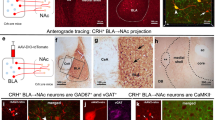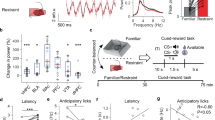Abstract
Mechanisms controlling release of brain-derived neurotrophic factor (BDNF) in the mesolimbic dopamine reward pathway remain unknown. We report that phasic optogenetic activation of this pathway increases BDNF amounts in the nucleus accumbens (NAc) of socially stressed mice but not of stress-naive mice. This stress gating of BDNF signaling is mediated by corticotrophin-releasing factor (CRF) acting in the NAc. These results unravel a stress context–detecting function of the brain's mesolimbic circuit.
This is a preview of subscription content, access via your institution
Access options
Subscribe to this journal
Receive 12 print issues and online access
$209.00 per year
only $17.42 per issue
Buy this article
- Purchase on Springer Link
- Instant access to full article PDF
Prices may be subject to local taxes which are calculated during checkout



Similar content being viewed by others
References
Park, H. & Poo, M.M. Nat. Rev. Neurosci. 14, 7–23 (2013).
Nestler, E.J. et al. Neuron 34, 13–25 (2002).
Nestler, E.J. & Carlezon, W.A. Jr. Biol. Psychiatry 59, 1151–1159 (2006).
Berton, O. et al. Science 311, 864–868 (2006).
Krishnan, V. et al. Cell 131, 391–404 (2007).
Grace, A.A. et al. Trends Neurosci. 30, 220–227 (2007).
Lobo, M.K. et al. Science 330, 385–390 (2010).
Lammel, S. et al. Neuron 70, 855–862 (2011).
Matsuda, N. et al. J. Neurosci. 29, 14185–14198 (2009).
Tsai, H.C. et al. Science 324, 1080–1084 (2009).
Cao, J.L. et al. J. Neurosci. 30, 16453–16458 (2010).
Koo, J.W. et al. Science 338, 124–128 (2012).
Chaudhury, D. et al. Nature 493, 532–536 (2013).
Koob, G.F. et al. Neurosci. Biobehav. Rev. 27, 739–749 (2004).
Tye, K.M. et al. Nature 493, 537–541 (2013).
Wanat, M.J., Bonci, A. & Phillips, P.E. Nat. Neurosci. 16, 383–385 (2013).
Cazorla, M. et al. J. Clin. Invest. 121, 1846–1857 (2011).
Lemos, J.C. et al. Nature 490, 402–406 (2013).
Pecina, S., Schulkin, J. & Berridge, K.C. BMC Biol. 4, 8 (2006).
Schnitzer, M.J. Nature 416, 683 (2002).
Acknowledgements
This work was supported by the National Institute of Mental Health (R01 MH092306: D.C. and M.-H.H.), Johnson & Johnson/International Mental Health Research Organization Rising Star Translational Research Award (M.-H.H.) and National Research Service Awards (F31 MH095425: J.J.W.; F32 MH096464: A.K.F.).
Author information
Authors and Affiliations
Contributions
J.J.W., A.K.F., H.S., E.A.H., S.M.K, B.J., V.L.B., M.S.M.-R., D.F., S.A.G., J.W.K., D.C. and D.J.C. collected and analyzed data. L.P., J.M.F., S.J.R. and E.J.N. generated and provided viral vectors and Thcre and BdnfloxP/loxP mice. J.J.W., E.J.N. and M.-H.H. designed the study and wrote the manuscript.
Corresponding author
Ethics declarations
Competing interests
The authors declare no competing financial interests.
Integrated supplementary information
Supplementary Figure 1 Viral placement and immunohistochemical validation.
(a) Schematic adapted from Allen Brain Atlas illustrating validation of NAc injection cite (scale 50 μm). Accurate injection sites were confirmed in all animals. (b) Schematic adapted from the Allen Brain Atlas showing VTA and confocal images showing co-expression of AAV-DIO-ChR2-eYFP and TH-positive cells in VTA that specifically project to NAc (scale 50 μm).
Supplementary Figure 2 Experimental timeline, viral injection schematic and behavioral sample traces.
(a) Schematic of PRV-Cre infused into NAc, AAV-DIO-ChR2-eYFP infused into VTA, and ferrule implantation into VTA with experimental timeline below. (b) Representative image of real-time tracing of animals during the social interaction test with optical stimulation. Left panel shows an eYFP control animal and right panel shows an animal that received phasic stimulation with ChR2.
Supplementary Figure 3 Subthreshold social stress alone does not induce social avoidant behavior and changes in NAc BDNF levels.
(a) Social interaction times of stress-naïve and subthreshold defeated animals (unpaired t-test, t8 = 0.125, P = 0.9004, n = 5,5 mice/group). (b) Quantification of NAc BDNF levels following subthreshold social (unpaired t-test, t8 = 0.253, P = 0.8069; n = 5,5 mice/group). (c) Full blot of Supplemental Figure 3b. Data presented as mean ± s.e.m.
Supplementary Figure 4 Schematic and validation of the retrograde AAV2/5-DIO-ChR2-eYFP in Thcre mice.
(a) Schematic of ChR2 into NAc and ferrule implantation into VTA of Thcre mice and timeline. (b) Confocal image showing co-expression of AAV2/5-DIO-ChR2-eYFP and TH-positive cells in VTA to NAc cells of Thcre (scale 25 μm). (c) Phasic light stimulation induced spiking in VTA-NAc DA neurons expressing AAV2/5.
Supplementary Figure 5 Timeline of experiments with stress-naive mice.
(a) Experimental timeline of stress-naïve mice with optical stimulation during social interaction. (b) Timeline of stress-naïve mice with five days of repeated optical stimulation (20 min/day).
Supplementary Figure 6 Schematics of experiments.
(a) Schematic and timeline of VTA-NAc neurons with cannula implantation into NAc for infusion of TrkB inhibitor, ANA-12, 1 h prior to behavior with stimulation. (b) Schematic and timeline showing targeting of VTA-NAc cells in BdnfloxP/loxP and controls.
Supplementary Figure 7 Intra-NAc CRF antagonist infusion.
(a) Timeline of animals that received intra-NAc CRF antagonist infusions. (b) Social interaction times of phasic stimulation of VTA-NAc neurons infected with AAV-DIO-eYFP (unpaired t-test, t10 = 0.091, P = 0.9291, n = 6,6 mice/group) and (c) BDNF level quantification (unpaired t-test, t8 = 0.38, P = 0.7112, n = 5,5 mice/group) after intra-NAc CRF antagonist infusion compared to vehicle. (d) Full blot of supplemental Figure 7c. Data presented as mean ± s.e.m.
Supplementary Figure 8 Intra-NAc infusions of CRF in stress-naive animals.
(a) Schematic and timeline of stress-naïve animals that received intra-NAc CRF infusions. (b) Social interaction times (F2,15 = 0.37, P = 0.7001, n = 6,6,6 mice/group) and (c) BDNF level quantification (F2,15 = 0.14, P = 0.8665, n = 6,6,6 mice/group) of animals that received phasic stimulation of VTA-NAc neurons infected with AAV-DIO-eYFP following intra-NAc CRF infusion or in animals that received tonic stimulation of VTA-NAc neurons infected with AAV-DIO-ChR2-eYFP compared to control. Data presented as mean ± s.e.m.
Supplementary Figure 9 Schematics of proposed mechanism of BDNF upregulation in the VTA-NAc circuit in the context of social stress.
(a) Schematic showing that stress gates the up-regulation of BDNF signaling in NAc by working together with phasic firing of VTA DA neurons that project to NAc as well as CRF actions in NAc, which may be both pre- and postsynaptic. (b) Schematic illustrating proposed interactions of BDNF and CRF in promoting stress susceptibility. Our data suggest that stress-induced CRF signaling in NAc activates its receptors located presynaptically on terminals of VTA DA neurons and works together with arriving phasic spikes from these DA neurons to release BDNF. BDNF then activates TrkB receptors located on NAc medium spiny neurons to promote susceptibility. Direct postsynaptic actions of CRF on these medium spiny neurons might also contribute to susceptibility.
Supplementary Figure 10 Full blots for all experiments.
(a) Figure 1b. (b) Figure 1d. (c) Figure 1f. (d) Figure 1h. (e) Figure 2b. (f) Figure 2d. (g) Figure 3b. (h) Figure 3d. (i) Figure 3f.
Supplementary information
Supplementary Text and Figures
Supplementary Figures 1–10 (PDF 6868 kb)
Rights and permissions
About this article
Cite this article
Walsh, J., Friedman, A., Sun, H. et al. Stress and CRF gate neural activation of BDNF in the mesolimbic reward pathway. Nat Neurosci 17, 27–29 (2014). https://doi.org/10.1038/nn.3591
Received:
Accepted:
Published:
Issue Date:
DOI: https://doi.org/10.1038/nn.3591
This article is cited by
-
CRF regulates pain sensation by enhancement of corticoaccumbal excitatory synaptic transmission
Molecular Psychiatry (2024)
-
CD200 in dentate gyrus improves depressive-like behaviors of mice through enhancing hippocampal neurogenesis via alleviation of microglia hyperactivation
Journal of Neuroinflammation (2023)
-
Stress-induced plasticity of a CRH/GABA projection disrupts reward behaviors in mice
Nature Communications (2023)
-
Neural circuits regulating prosocial behaviors
Neuropsychopharmacology (2023)
-
The laterodorsal tegmentum-ventral tegmental area circuit controls depression-like behaviors by activating ErbB4 in DA neurons
Molecular Psychiatry (2023)



